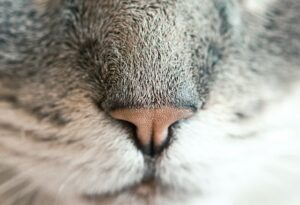
Photo by Ryan McGuire on Unsplash
Tanya Lewis writes Cat Noses Contain Twisted Labyrinths That Help Them Separate Smells (‘Scientists hypothesize that coiled channels inside a cat’s nose may function like a gas chromatograph’):
[spacer height=”100px”]Researchers created a computational model of a cat’s nose based on computed tomography scans and tissue slices from a deceased house cat whose body was donated for research. When a cat takes a sniff, airflow is diverted into two different streams for breathing and smelling. The model showed that the animal’s nasal passages then direct the smelling stream through an extensive network of tightly coiled, sensor-studded channels called turbinates. The scientists hypothesize that this structure may function like a gas chromatograph—a sophisticated chemical device that separates different compounds based on their solubility. Scents that dissolve less easily in nasal mucus travel farther than more readily dissolved ones and therefore bind to more distant smell receptors.
“We know that animals—including cats—use a sense of smell for detection of food, for sense of danger and also for kin recognition,” says Kai Zhao, a bioengineer in the department of otolaryngology at the Ohio State University and senior author of the study. The coiled structure the researchers documented is more than 100 times more efficient than the straight channel found in the noses of amphibians and some mammals, and it can fit more smell receptors in a confined head space, Zhao notes. The study was published on Thursday in PLOS Computational Biologyand was partially funded by Mars Petcare UK, a company that manufactures pet food.
